If you’re on the hunt for spiders that are black and white in color, then you’ve come to the right place! In this article, you will find 24 stunning species of spiders that feature a striking black and white coloration.
From the bold and beautiful jumping spiders to the delicate and intricate orb-weaver, each of these spiders is a true marvel of nature. We have also provided you with detailed information about the spider’s physical characteristics, habitat, behavior, and background.
This way you can learn everything you need to know about each species of spider as you go down the list. So, join us as we explore the world of these back and white spiders and see what you can learn.
24 Black And White Spiders With Photos!
1. Zebra Jumping Spider
The Zebra Jumping Spider, also known as (Salticus scenicus), is a striking spider that is instantly recognizable for its black and white zebra-like stripes that cover the spider’s body, including their legs, cephalothorax, and abdomen.
However, depending on the spider’s age these stripes are not always the same pattern or size! For example, younger spiders tend to be less noticeable than the adults, and thinner with more irregular shapes.
With that said, like, most jumping spiders, the adult zebra spiders are quite small with females only growing up to 9 mm in length, while the males are slightly smaller around 6 mm.
These spiders are typically found throughout Europe, North America, and North Asia, and can be found in a variety of habitats, including forests, meadows, and gardens.
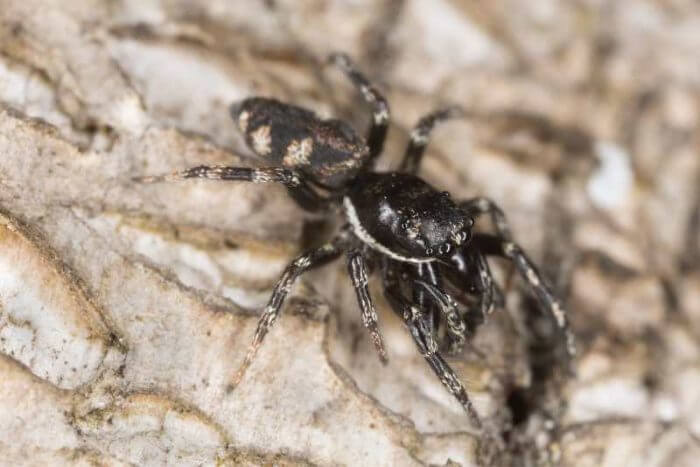
But, despite their somewhat intimidating appearance, the Zebra Jumping Spider is harmless to humans and is actually considered excellent pets, and a beneficial predator.
When it comes to their hunting skills, the zebra spider uses its exceptional eyesight to locate and capture their prey. Once in range, they will pounce on it with lightning speed immobilizing it “and then” well, you know the rest!
Characteristics
- Striking black and white zebra-like stripes on their cephalothorax, and abdomen
- They have eight eyes with two enlarged anterior median eyes
Habitat
- Can be found in forests, meadows, and gardens
- Regular nesting grounds include rocks, shingle beaches and occasionally trees.
Related Article:
2. Bold Jumping Spider
The Bold Jumping Spider, (Phidippus audax), is one of the most common species of jumping spiders. Found throughout North America, these spiders are known for their bold and curious behavior, as well as their striking black and white color.
The Bold Jumping Spider is a relatively large species of jumping spider, with females growing up to 15 mm in length and males up to 13 mm. The spider’s body is covered in short, dense black and white hairs, giving it a velvety appearance.
However, the black and white coloration is not in distinct stripes like the Zebra Jumping Spider, but rather in a pattern of spots and patches.
But, what sets this species apart is their green, almost bluish chelicerae! With the adult male’s chelicerae being much more noticeable than the females.
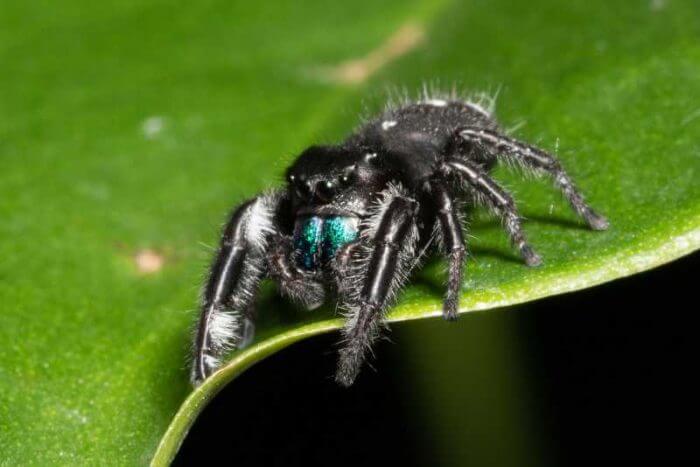
They also have the presence of a distinct white triangle in the center of their back, with two smaller spots below it. These unique patterns are a defining feature of the Bold Jumping Spider and are often used by researchers and enthusiasts to distinguish it from other jumping spider species.
Characteristics
- Black body with white spots, and patches
- Green and blue chelicerae
- Short, black and white hairs
Habitat
- Prefers, grasslands, open woodlands, chaparrals, and agricultural fields
3. Crablike Spiny Orb Weaver
The Crablike Spiny Orb Weaver (Gasteracantha cancriformis) is a truly remarkable spider, with a striking crab appearance that sets it apart from other arachnids. Their carapace, legs, and underside are black, with white spots visible under the spider’s abdomen.
The color of the upper side of the abdomen can vary, for example, those with a white upper side can have either red or black spines, while a yellow upperside can only have black ones.
When it comes to their size, the females are typically between 5 and 9 mm (0.20–0.35 in) in length and 10-13 mm (0.39–0.51 in) in width.
Males, on the other hand, are much smaller, measuring only 2 to 3 mm in length, and are longer than they are wide.
Like females, males also have six abdominal spines, but their abdomen is gray with white spots, and their spines are reduced to four or five stubby projections.
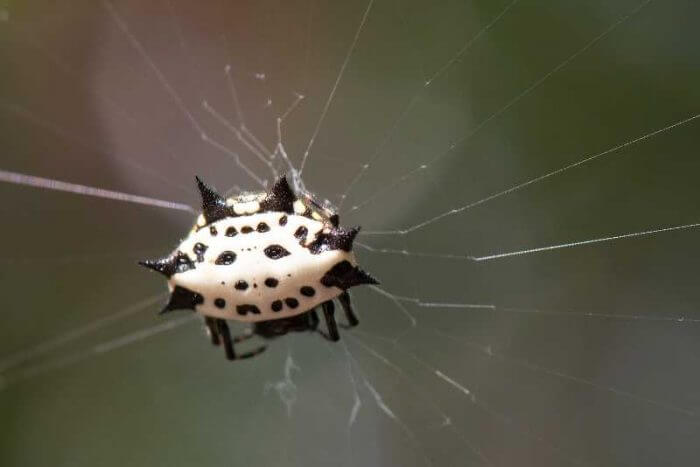
But, despite their unique appearance, the lifespan of the Crablike Spiny Orb Weaver is relatively short. Females typically die after producing an egg mass, and males die six days after completing a cycle of sperm induction to the female.
This means that the spider’s life is focused solely on reproduction, with little time for anything else.
Characteristics
- Black or red spines on their abdomen
- White spots visible under the abdomen
- Crablike appearance with some having a white or yellow upperside
Habitat
- Native to North America, Central America, the Caribbean, and South America
- Has been seen nesting around woodlands, and shrubby gardens
4. White-Backed Garden Spider
The White-Backed Garden Spider, also known as the (Araneus diadematus) is a striking spider species that is known for its distinctive white or yellowish-white stripe down the center of its abdomen, with four or more segments forming a cross black
Their body can range from a light yellow to very dark grey, almost black color! The White-Backed Garden Spider is a relatively large spider, with females measuring between 6.5 to 20 mm (0.26 to 0.79 in) in length, while males are smaller, measuring between 5.5 to 13 mm (0.22 to 0.51 in).
The spider’s legs are long and slender, with black and white or yellowish-white bands that match the color of its body.
However, apart from their color, one of the most fascinating aspects of the White-Backed Garden Spider is its orb webs. This spider’s web is very large and quite complex, with a distinctive zigzag pattern known as a stabilimentum.
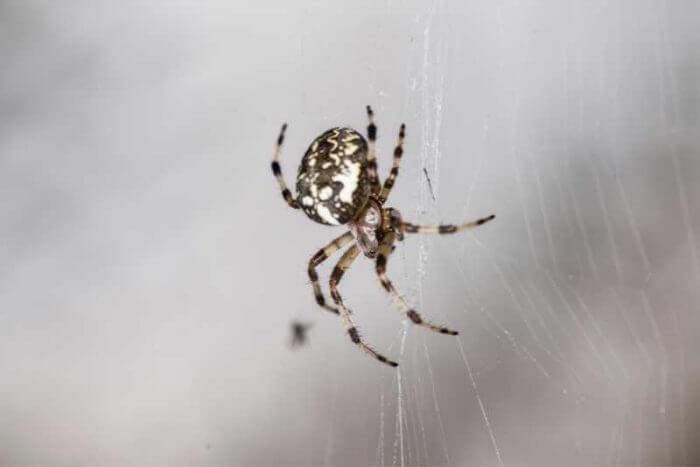
This pattern is thought to serve a number of different purposes, including making the web more visible to prey and potential mates, as well as providing additional structural support.
This spider is very common in gardens and backyards, and is not considered dangerous to humans! In fact, this garden spider is actually a valuable predator of many insect pests. So, if you do see one in your garden, it’s best to leave it be!
Characteristics
- Yellowish-white stripe down the center of its abdomen
- Light yellow to very dark grey body with four or more segments forming a cross black
Habitat
- Typically found nesting in gardens and backyards
- These spiders are native to parts of Europe mainly the UK
5. Coppered White-Cheeked Jumping Spider
The Coppered White-Cheeked Jumping Spider, also known as the (Pelegrina aeneola), is a species of spider that belongs to the Salticidae family. Its head and thorax are copper-colored, while its cheeks are white, which is why it’s called the coppered white-cheeked spider.
When having a closer look your notice that their legs are covered in tiny white hairs, with black stripes at each nuckle. Their front legs are slightly longer than the others, with their abdomen also being covered in fine hairs, similar to the bold jumping spider.
The copper coloration of the head and thorax is particularly striking, and it can range from a bright, shiny copper to a more muted, brownish-copper color.
The white cheeks are also quite prominent and help to distinguish this species from other jumping spiders.
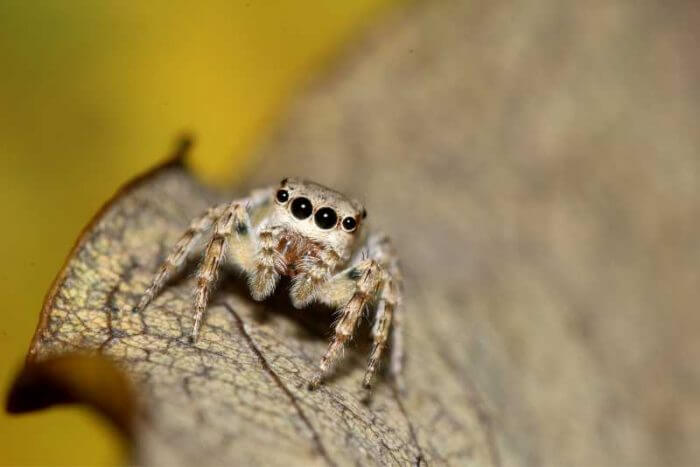
The black and white striped legs of these spiders are another distinctive feature, and can actually help them camouflage against their surroundings.
When the spider is at rest, it often holds its legs in a characteristic “X” shape, which further enhances its camouflage.
Overall, the Coppered White-Cheeked Jumping Spider is a beautiful and unique species of spider that is easily recognizable by its striking coloration and distinctive appearance.
Characteristics
- The head and thorax range from copper to a more muted, brownish-copper color.
- Legs are covered in tiny white hairs with black stripes at each knuckle
Habitat
- Can be found throughout western North America
- Typically nests in shrubs, grass, and even on understory vegetation
Related Article:
6. False Black Widow
The False Black Widow, (Steatoda grossa), is a spider species that is often mistaken for the true Black Widow due to its similar appearance. However, what makes them different from one another is their color.
While the true black widow is black with red spots, the false black widow is lighter in color, and instead of red spots on its abdomen, this one has white. These white markings can vary in shape and size, but they usually form a series of spots or stripes.
Despite its name, the False Black Widow is not as venomous as the true Black Widow.
Its venom is still potent enough to cause discomfort and pain, but it’s not considered life-threatening for humans.
The False Black Widow is commonly found in urban areas, such as buildings, gardens, and garages.
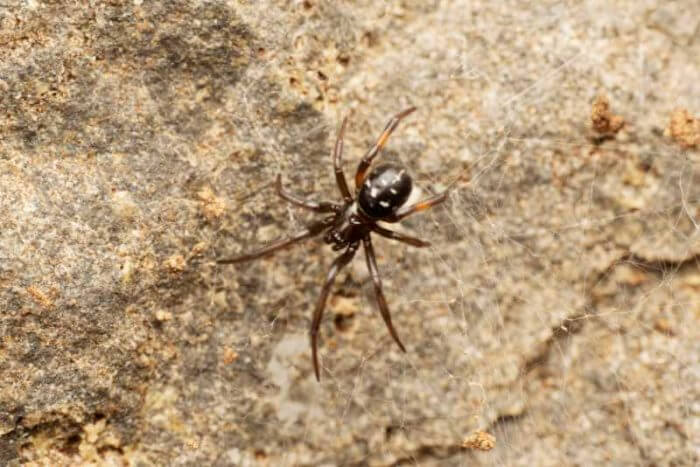
If you come across one of these spiders, it’s important to exercise caution and avoid touching it. While the False Black Widow is not as dangerous as the true Black Widow, it can still cause harm if provoked or threatened.
Characteristics
- White spots on their abdomen
- Abdomen pattern is described as skull-shaped
- Their legs are reddish-brown, with a black body
Habitat
- Native to the UK and Ireland
- They can be found building webs in houses and buildings
7. Red-Femured Spotted Orbweaver
The Red-Femured Spotted Orbweaver, also known as (Neoscona domiciliorum), is a species of spider that is commonly found in North America. As the name suggests, this spider legs are red while the remaining segments are banded in black and grey with four spots on their abdomen which is typically white and black in color.
These markings are easier to see on fully grown adults and are typically flanked by broad black stripes on either side, with a slender transverse white band positioned near the anterior end, forming a pale cruciform shape.
These spiders also have a longitudinal groove on their carapace which sets them apart from other species. When it comes to their size, they can vary depending on their gender and age.
For example, with most spiders, the females are generally larger than males, with an average length of about 7 to 16mm (0.28 to 0.63 in).
Males, however, are typically smaller, with an average length of 8 millimeters (0.31 in).
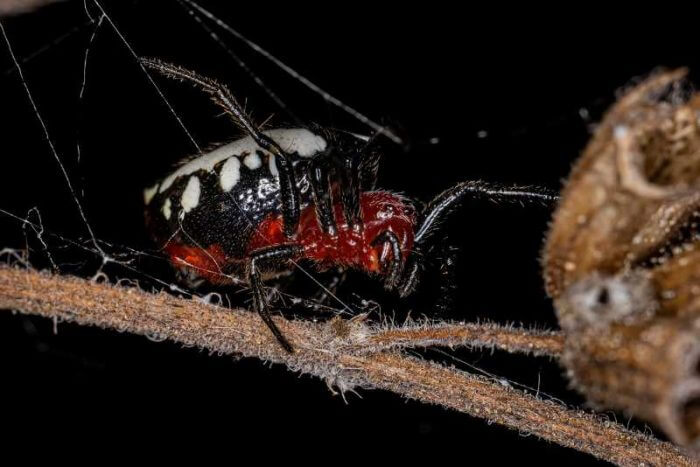
The Red-Femured Orbweavers are typically found in wooded areas, gardens, and around buildings. They are known to build orb-shaped webs that are used to catch prey, such as insects and other small animals.
Characteristics
- Four white spots on their abdomen
- Each leg is red while the remaining segments are banded in black
- Longitudinal groove on their carapace
Habitat
- Can be found in the United States, southeast of Texas, Indiana, and Massachusetts
- They typically nest in wooded areas, gardens, or in buildings
8. Spined Micrathena
The Spined Micrathena spider, also known as (Micrathena gracilis), is a species very similar to the crablike spiny orb weaver, mentioned earlier, and can be found in North and Central America.
These spiders are known for their striking appearance, one of the black and white spiders with a distinctive black and white spiny abdomen, with some spiders having a yellow color on their sides.
In fact, the most recognizable feature of the Spined Micrathena spider is its spiny abdomen. Which is covered in sharp, pointed spines that are thought to provide some protection against predators.
Spined Micrathena spiders are relatively small, with females typically measuring around 8 to 10mm in length and have five pairs of black spines, males on the other hand are slightly smaller.
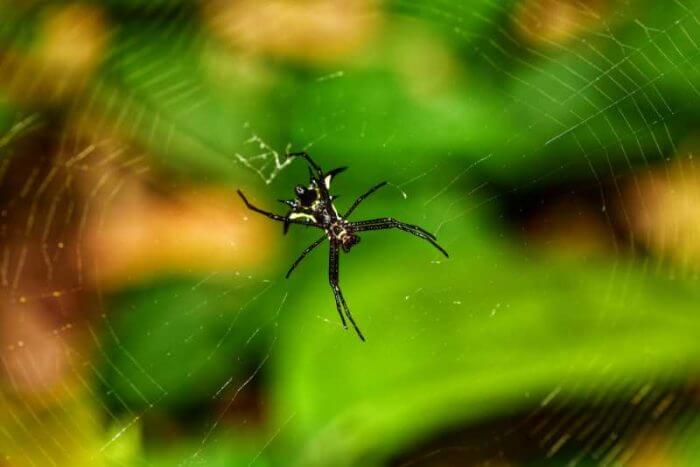
Males also have fewer spines, compared to the female with a flatter abdomen, and a slightly lighter tone. They are most commonly found in wooded areas, where they build large webs up to 20cm in length typically between branches and leaves.
Characteristics
- Distinctive black and white spiny abdomen
- Some species have yellow on their sides
- Females have five pairs of black spines
Habitat
- These spiders are native to North and Central America
- Prefers to nest in woodland areas mainly in Oak and Hickory trees
9. Gray Wall Jumping Spider
The Gray Wall Jumping Spider, also known as (Menemerus bivittatus), is a species of spider found in many parts of the world, including Asia, Africa, and America. This spider has a dorso-ventrally flattened-like body and is covered in short, dense, gray and white hairs with tufts of dark brown bristles near their eyes.
Males have a blackish longitudinal dorsal stripe with brownish-white stripes on either side of the abdomen. Their carapace and chelicerae are also black and white, and the legs have transverse bandings of the same colors.
The females, however, are generally paler and more brown in color, with a larger carapace and abdomen.
She has a carapace edged with two black bands and a thin white stripe, and her abdomen is edged with broad black stripes on each side that unite at the posterior end.
Her legs are banded, but they are paler than those of the male. Immature spiders resemble the female in appearance.
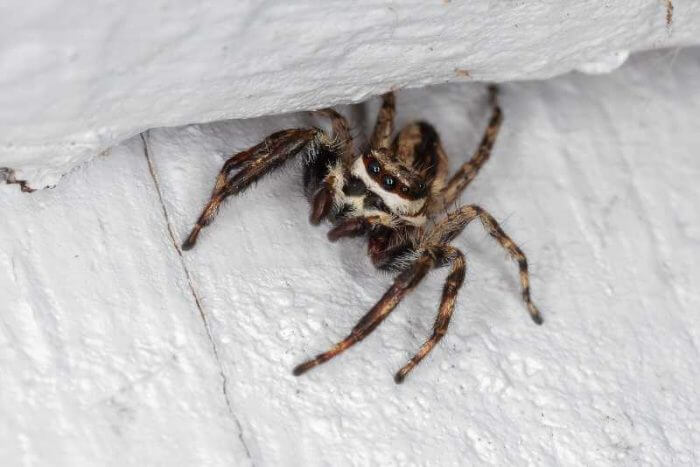
These spiders typically measure around nine millimeters in length, with the males being slightly smaller than the females. These spiders are usually found on walls or on tree trunks where they stalk their prey.
Characteristics
- Males have a black and white carapace, chelicerae
- Their legs have transverse bandings of the same colors.
- Females have carapace is edged with two black bands and a thin white stripe
- Her abdomen is edged with broad black stripes
Habitat
- These species can be found in Florida, Texas, and California
- Can be found on walls and tree trunks, hunting for prey
10. Bronze Jumping Spider
The Bronze Jumping Spider, scientifically known as (Eris militaris), is a species of spider commonly found in and around the United States and Canada. These spiders are known for their distinctive bronze color, which results from the tiny hairs that cover their body.
When looking at their color, the female’s abdomen is slightly darker, with white spots. However, the males have a lighter abdomen and a darker “almost black” cephalothorax, with white bands along their sides.
While the females lack white bands on their cephalothorax, they do have them on their abdomen.
The male’s chelicerae, which have fang-like features, are long and located at the front of their cephalothorax.
Like with most spiders, the females are larger and can grow up to 8mm, whereas, the males only grow to 6.7mm.
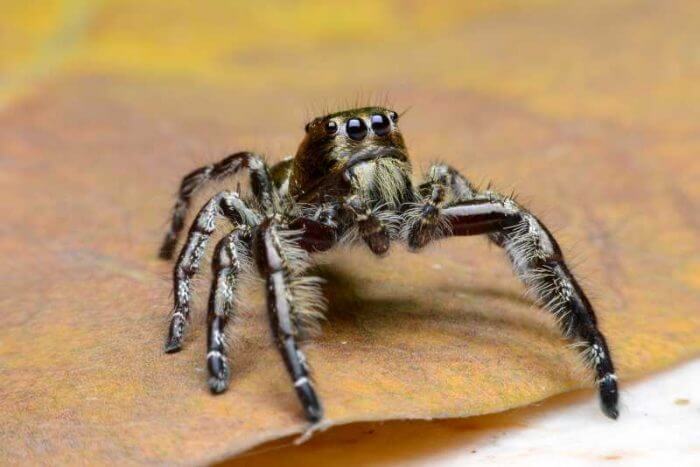
These Bronze Jumping Spiders can be commonly found together in groups, under surfaces, such as dead wood, as they are easily camouflaged due to their bronze color. They may also hide in blackberry bushes, where they use the leaves to create small shelters.
Characteristics
- Distinctive tiny bronze-like hairs
- Males have a lighter abdomen and a darker cephalothorax, with white bands along their sides
- Female’s abdomen is slightly darker, with white spots, and lacks the white bands
Habitat
- Native to the United States and Canada
- Can be found in groups under dead wood and blackberry bushes
Related Article:
11. Purseweb Spider
The Purseweb Spider, also known as, (Atypus) is a type of spider that belongs to the family Atypical Tarantula. It is one of the black and white spiders because they have a dark brown and black appearance, with distinct greyish-white lines where the jaws meet the carapace.
The front of the carapace is very square, and the females typically have a larger, almost white abdomen compared to males. The females can also grow up to 15mm, while the males only reach 9mm in size.
Purseweb spiders are named for the tube-like structure, that looks more like a sock-shaped silk, that they construct as a retreat. The spider builds a silk tube that is usually attached to a tree or other vertical surface.
The spider then waits at the entrance of the tube for prey to pass by. When prey comes close enough, the spider rushes out and captures it, pulling it back into the tube to eat.
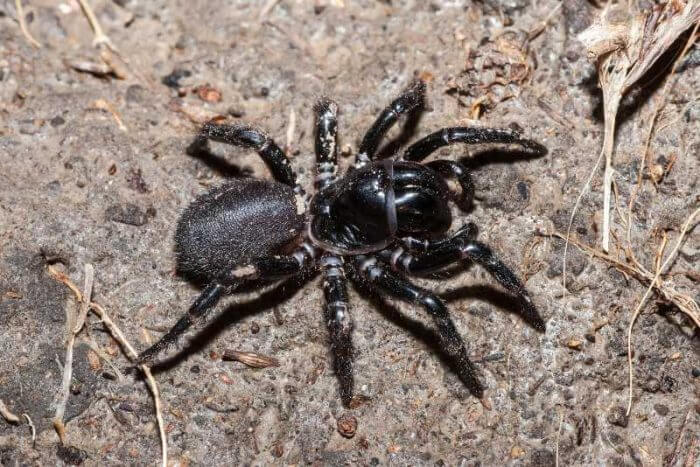
Like most tarantulas, these spiders are not considered dangerous to humans, as they are not aggressive. In fact, they are considered generally shy and reclusive, and spend most of their time hidden away in their nest.
Characteristics
- Dark brown and black appearance
- Distinct greyish-white lines close to the jaws and carapace
- Females typically have a larger, white abdomen
Habitat
- Native to partd of the United Kingdom
- Can be found in grasslands, and on sandy or chalky soils
12. Buttonhook Leaf-Beetle Jumping Spider
The Buttonhook Leaf-Beetle Jumping Spider (Sassacus vitis) is a species of spider known for its unique and distinctive appearance. It is one of the black and white spiders becuase their body color can range from dark brown to black, with white markings typically found on the spider’s abdomen and legs.
Females tend to be much duller in color compared to the males and larger up to five millimeters in length. Because of their size, these spiders primarily feed on small insects and flies found on plants.
The buttonhook spider is native to parts of North America but can also be found in Canada and Panama.
One interesting fact about this spider is that it is named after its prey, the Buttonhook Leaf-Beetle, which it closely resembles in appearance.
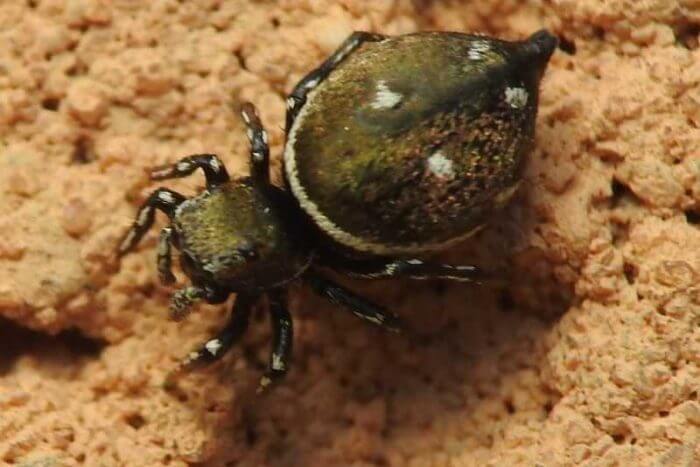
This is a common tactic used by many spider species to camouflage themselves and avoid detection by predators.
Overall, the Buttonhook Leaf-Beetle Jumping Spider is a fascinating species that has evolved unique hunting strategies and physical adaptations to survive in their environment.
Characteristics
- Their body color can range from dark brown to black
- White markings on their abdomen and legs
Habitat
- Native North America, Canada, and Panama
- Can be found on plants, such as elderberries
13. White Micrathena
The White Micrathena (Micrathena mitrata) is a species of orb-weaving spider that is commonly found in the United States and Brazil. Their appearance can look similar to the Crablike Spiny Orb Weaver, mentioned earlier, with their spikes, but this one has a larger and more rounded abdomen.
The color of the Micrathena mitrata can vary, but their body is typically black or dark brown in color, with a white abdomen. They have eight yellowish-brown legs and two pairs of spinnerets that they use to spin their webs.
The spinnerets are located at the tip of the spider’s abdomen and are responsible for producing different types of silk, which the spider uses for various purposes such as web-building and wrapping prey.
In addition to spinnerets, they also possess venom glands that produce a potent venom used to subdue and kill its prey. However, they are not considered dangerous to humans
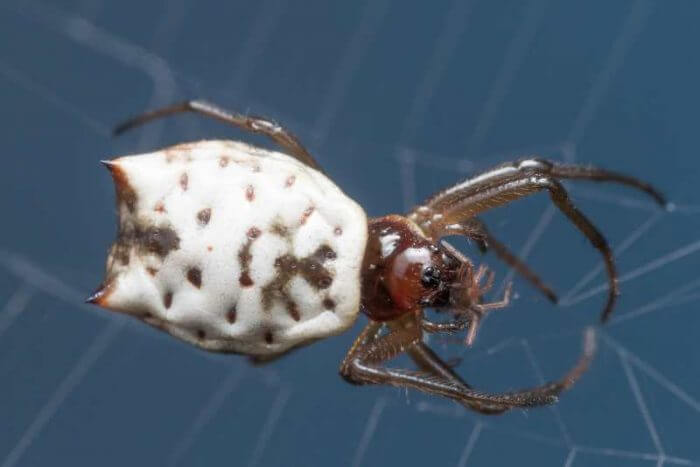
Their size can vary from 4 to 9 mm for females and 3 to 4 mm for males! However, it’s usually the females that are larger in size. These spiders are commonly found in eastern and central regions of the United States, and Canada, and well typically nest in wooded areas.
Characteristics
- They have eight yellowish-brown legs, with a black or dark brown body
- Large white abdomen with two pairs of spinnerets at the tip
Habitat
- Native to eastern and central regions of the United States, and Canada
- Builds nests in shrubs and trees, close to slow-moving water (streams)
14. Eastern Parson Spider
The Eastern Parson Spider (Herpyllus ecclesiasticus) is a species of spider that is commonly found in North America east of the Rocky Mountains. These spiders are covered with black hairs on the cephalothorax with gray hairs on their abdomen and a distinctive white mark on the spider’s back.
The legs of the Eastern Parson Spider are very long, with the first two pairs being longer than the rest. At the tip of its abdomen, the Eastern Parson Spider has two spinnerets that is used to produce different types of silk for various purposes.
However, like most spiders that spin webs, this species doesn’t. Instead, they build funnels similar to wolf spiders and jumping spiders.
When hunting, the Eastern Parson Spider will use its excellent vision to locate potential prey. Once spotted they will slowly approach it, using its long, slender legs, and then once in range pounce on it using its sharp fangs to inject venom and subdue it.
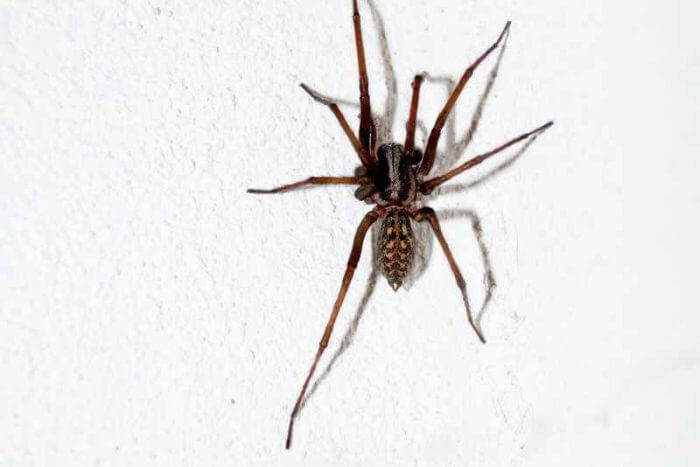
But, when looking for one of these spiders, it can be a challenge as they are mostly nocturnal (meaning they hunt at night) and are rarely seen during the day. Their size can also make this difficult as they only grow 8 to 13 millimeters long and males are even smaller 6 millimeters in length
Characteristics
- Black hairs on it’s cephalothorax with gray hairs on their abdomen
- Distinctive white marks on their back, with two spinnerets tip of their abdomen
Habitat
- Native to North America east of the Rocky Mountains
- Can be found nesting under rocks, bushes, and old firewood.
15. Peppered Jumping Spider
The Peppered Jumping Spider, (Pelegrina galathea) is a small but fascinating species of spider that can be found throughout much of North America, Canada, and Costa Rica. These spiders are known for their distinctive black and white stripes on their legs and body, which resemble a salt and pepper pattern, hence their name.
Like all jumping spiders, peppered jumping spiders have excellent eyesight, which gives them exceptional depth perception, allowing them to accurately judge the distance to their prey before making their move.
They have a total of eight eyes, which are arranged in three rows, and they use their sharp vision to locate prey and potential mates.
Peppered Jumping Spiders are known to be particularly fond of plants such as grasses, shrubs, and flowers. They may create their nests in the crevices of leaves or stems, or in the flowers themselves.
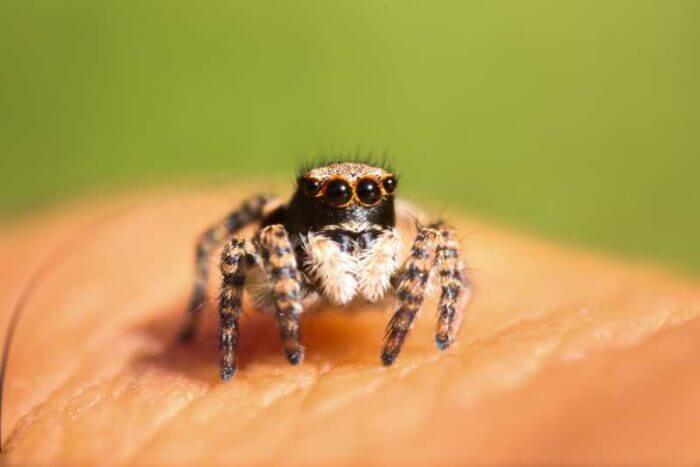
They also sometimes nest in man-made structures such as fences, walls, and buildings. The nests of Peppered Jumping Spiders are typically small and inconspicuous, making them difficult to spot.
However, if you look closely, you may be able to see a small silk structure that resembles a tiny tent or cocoon.
Characteristics
- Black and white stripes on their legs and body
- Eight eyes, which are arranged in three rows
Habitat
- Native to North America, Canada, and Costa Rica
- Can be found in grassy areas with plenty of sunshine
Related Article:
16. Bowl And Doily Spider
The Bowl And Doily Spider, also known as (Frontinella Pyramitela), is named for their unique web structure, which resembles a dome-like web, or “bowl,” that’s typically suspended above a horizontal sheet web.
The bowl and doily spider has a distinctive reddish-brown color, with yellowish-colored legs. However, the male’s legs and body have a more black and red appearance compared to the females, with white dots on the spider’s abdomen.
The spiders themselves are relatively small, with females measuring up to 4 mm (0.16 in) in length and males being slightly smaller.
They can be found in North and Central America and they usually build their webs in weedy fields and in shrubs.
They are most active throughout May June, and September.
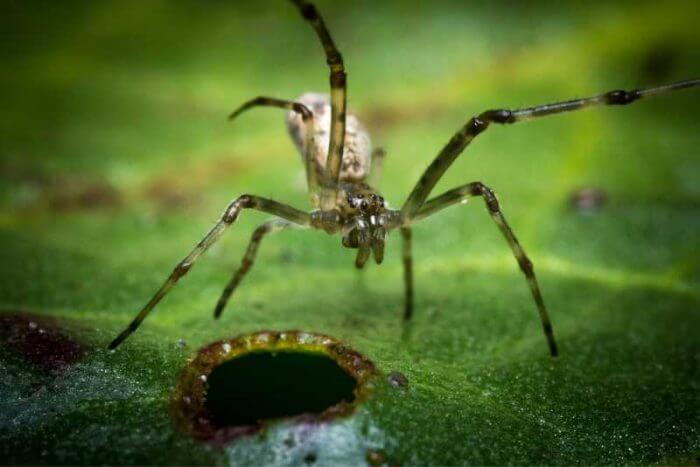
These spiders will spend most of their time sitting in their bowl, waiting for prey to get caught in the web. Once an insect lands on the doily, the spider quickly moves in to capture their prey!
Characteristics
- Reddish-brown color body with yellowish colored legs
- Look for white dotts on the spider’s abdomen
Habitat
- Native to North and Central America
- Can be found in temperate woods, alpine forests, weedy fields, and in shrubs
17. Nordmann’s Orbweaver
Nordmann’s Orbweaver, also known as (Araneus nordmanni), is a species of orb weaver from the Araneidae family. These spiders have a black and gray colored body with white spots on and underneath their abdomen with hairy spiny legs.
They have a large abdomen that overlaps the back edge of the cephalothorax. However, with most spiders, the males have smaller abdomens compared to the females.
The Nordmann’s Orbweaver are nocturnal spiders, meaning that they are most active at night.
During the day, they will hide in a sheltered area such as a leaf or under bark. At night, they will emerge to spin their webs and hunt for prey.
These spiders also spin large circular webs that can measure up to 50cm in diameter.
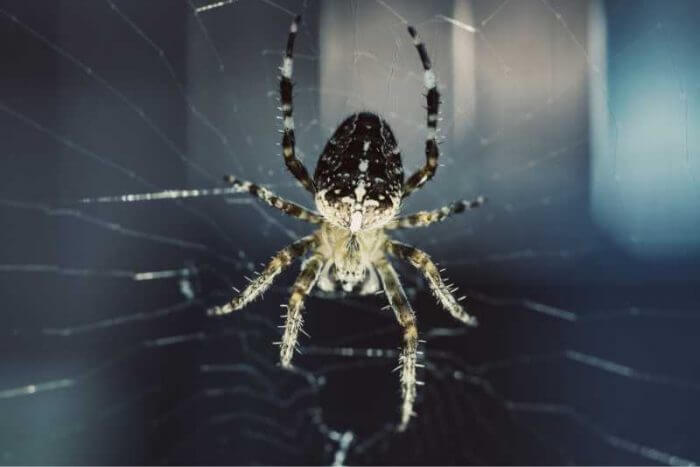
Their webs are made up of sticky silk that is used to capture insects. Once an insect gets caught in the web, the spider pours on it and typically consumes it there and then!
Characteristics
- Black and gray colored body with white spots on their abdomen
- They have small thin hairs down each leg
Habitat
- Native to North America, and Europe
- Can be found in spruce forests and cold areas, especially in mountains
18. Spotted Ground Swift Spider
The Spotted Ground Swift Spider, (Nyssus coloripes), also known as the orange-legged swift spider is a unique and fascinating species that can be found in many parts of the world.
These Orange-legged swift spiders are black in appearance, with white spots all over their body, and orange front legs. Their body is elongated and flattened, giving them a streamlined appearance.
The Spotted Ground Swift Spider is known for its swift movements. This spider is incredibly agile and can move quickly across a variety of surfaces, including walls, ceilings, and even glass.
It is also known for its ability to spit a sticky web-like substance, which it uses to immobilize prey and defend itself against predators.
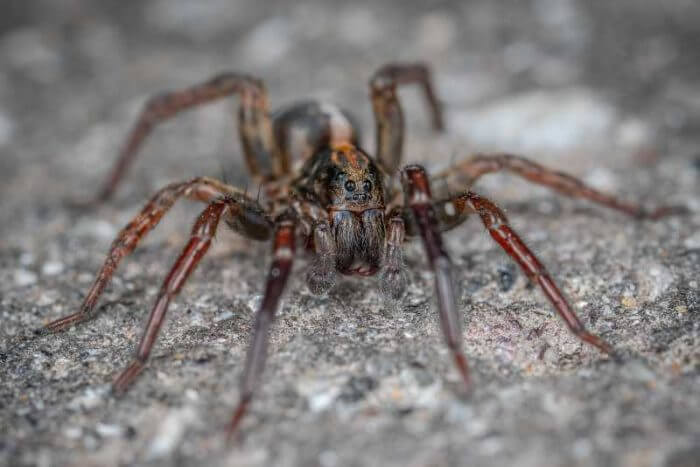
Overall, the Spotted Ground Swift Spider is a fascinating and unique species that is sure to capture the imagination of anyone who encounters them. With their distinctive appearance and swift movements, these spiders are a true wonder of the natural world.
Characteristics
- Black in appearance, with orange front legs
- White spots all over their body
Habitat
- Native to Australia, and New Zealand
- Commonly found in homes and in gardens
19. Sylvan Jumping Spider
The Sylvan Jumping Spider, also known as the (Colonus sylvanus), is a small but fascinating species of spider that can be found in the United States and Panama. These spiders are very small only measuring 6.5 mm for males and the females 7.4 mm.
These spiders have a distinctive appearance with a short narrow body, long legs, and large eyes. They are typically black, and brown in color, with white and yellow markings on their abdomen.
However, their color can vary in intensity and complexity depending on the individual spider.
Some spiders have simple black and white stripes, while others have more intricate patterns that include spots, dashes, and other shapes.
The sylvan spider does have a toxic bite, but they are typically targeted at their prey and predators. They are usually not fatal to humans.
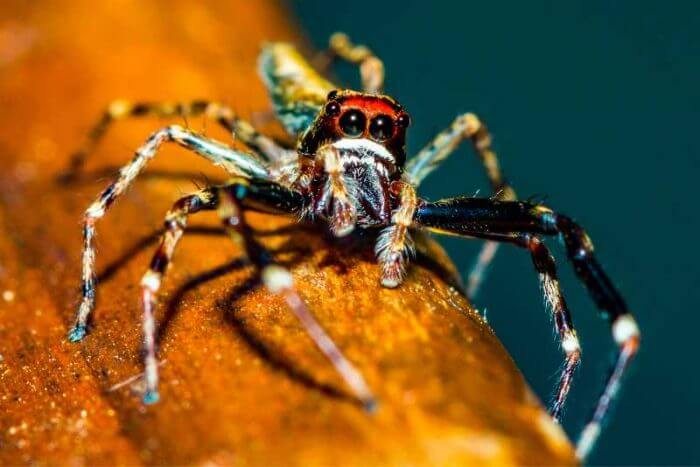
With that said, their bite can still cause a nasty rash if bitten, so it’s probably a good idea to keep your distance if you see one!
Characteristics
- White and yellow markings on their abdomen
- Black and brown short narrow body
Habitat
- Native to United States and Panama
- Generally nests in large plants
20. Pantropical Jumping Spider
The Pantropical Jumping Spider, (Plexippus paykulli) is a small but highly acrobatic spider that can be found in tropical regions such as Africa and Asia. These spiders are known for their incredible jumping abilities, which allow them to leap great distances in order to catch their prey.
The male pantropical jumping Spider has a black carapace and abdomen with a broad central stripe in white, two additional broad white stripes on either side and a pair of white spots near the posterior end of the abdomen.
The stripe extends to the anterior eyes, giving the appearance of three white stripes on a black background.
On the other hand, the female is mostly brownish-grey, with a darker carapace, especially around the eyes, and a broad tan stripe that extends onto the abdomen, where it breaks into two chevrons.
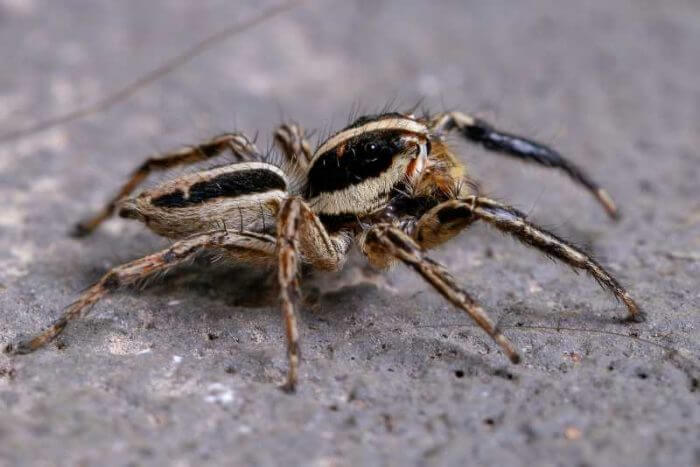
The female also has two white spots on either side of the posterior end of the abdomen. When it comes to their size, the females are 9 to 12 mm in length, and the males are 9 to 11 mm.
Characteristics
- Males have a black carapace and abdomen with a broad central stripe in white
- Female are usually brown and grey, with a darker carapace
Habitat
- Native to southeast Africa and Asia
- Can be found in light areas, around man-made structures, such as buildings, or walls
21. Twin-Flagged Jumping Spider
The Twin-Flagged Jumping Spider, also known as the (Anasaitis canosa), is a species of jumping spider that is native to Mexico, South Carolina, and the Gulf of Mexico. These spiders get their name from their unique flag markings on the dorsal side of the cephalothorax.
The twin-flagged jumping spider has a black body with iridescent setae (in other words, scales) that can be white, green, or pink which resemble “flags”. The males have patches on their pedipalps used in courtship and intraspecific signaling.
The males are known for their elaborate courtship display, which involves raising and waving their legs and displaying colorful flags to attract a female.
The female, in turn, will respond by either accepting or rejecting the male’s advances.
As for their size, the females are typically larger growing to around 5 to 6 mm in length.
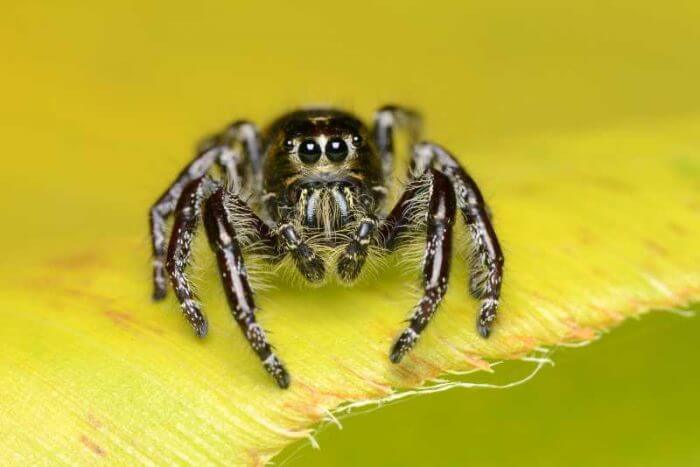
When it comes to their prey, these jumping spiders, or any other spider for that matter, are one of the few that actually eat’s and consume ants!
Characteristics
- Flag markings (scales) on their cephalothorax
- Black body with white patches on legs and face
Habitat
- Native to Mexico, South Carolina, and the Gulf of Mexico
- Can be found nesting
22. White Cheeked Jumping Spider
The Common White-Cheeked Jumping Spider, also known as the (Pelegrina aeneola) is a species of jumping spider that is found in North America. These spiders are small, measuring 5.5 millimeters in length for females and 5 millimeters for males.
The White-Cheeked Jumping Spider is quite unique, with the females being mostly white in color with brown on the top of their abdomen, black on their forehead, and a touch of brown on their legs. The male spiders legs and pedipalps are black, with a dark brown carapace, and lighter brown abdomen compared to the females with white markings on their pedipalps legs and abdomen.
These spiders also have a row of four eyes, starting with the anterior median eyes (AME) and ending at the anterior lateral eyes (ALE), which curve backward.
The AMEs are the largest eyes in this display, and they are nearly twice as large as their ALE counterparts, making them easily distinguishable.
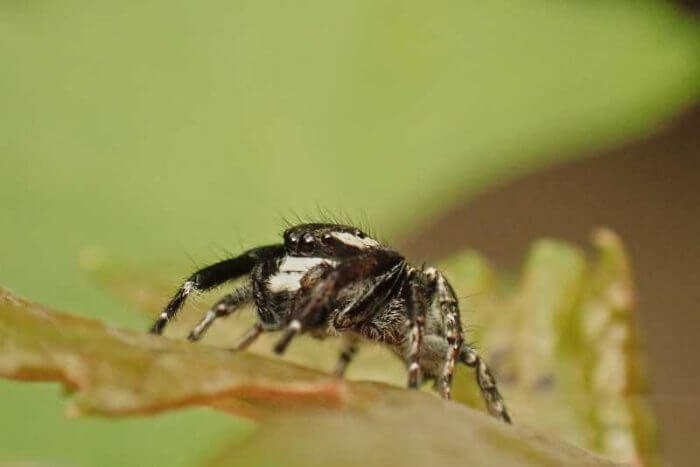
White-cheeked jumping spiders typically inhabit a variety of habitats, including fields, forests, and grasslands. They are active during the day and observers can often spot them perched on leaves, twigs, or other structures as they hunt for prey.
Characteristics
- Females body mostly white in color with a brown abdomen, black forehead, and brown legs
- Males body, legs, and pedipalps are black, with white markings, a dark brown carapace, and a lighter abdomen
Habitat
- Native to North America
- Often seen perched on leaves, twigs
23. Two-Lined Stealthy Ground Spider
The Two-Lined Stealthy Ground Spider, (Cesonia bilineata), is a small spider species that belongs to the family Gnaphosidae. These spiders are found in various habitats across North America, including forests, grasslands, and deserts.
The Two-Lined Stealthy Ground Spider has a distinctive appearance that helps it blend in with its surroundings. The spider’s body is generally dark brown or black, with two bright white stripes running down its back. These stripes can also be yellow, or cream-colored, and they are often bordered by darker lines.
As their name suggests, Two-Lined Stealthy Ground Spiders are stealthy predators that hunt on the ground.
They have a distinctive color pattern, with two light-colored stripes running down their dark brown or black body.
These stripes help them blend in with their surroundings and remain hidden from predators and prey.
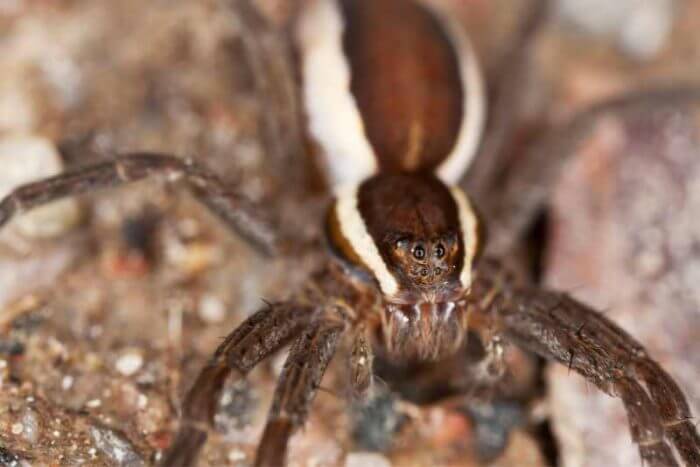
Two-lined stealthy Ground Spiders are also known for their agility and speed. They use their sharp senses and quick reflexes to track and capture insects, other spiders, and small invertebrates.
Characteristics
- They are dark brown or black, with two bright white stripes running down their back
- In some cases, stripes can also be yellow, or cream-colored, bordered by darker lines.
Habitat
- Native to North America
- Can be found in and around forests, grasslands, and deserts
24. Ant-Mimic Sac Spider
The Long-Palped Ant-Mimic Sac Spider, also known as the (Castianeira longipalpa), is a spider species that belongs to the family Corinnidae.
The Long-Palped Ant-Mimic Sac Spider has a distinctive appearance that helps it mimic ants, which is a form of protective mimicry. The spider’s body is elongated and flattened, with a slightly curved shape. Their coloration is usually reddish-brown or black, with white almost cream patches on their abdomen.
They are relatively small, with a body length of around 5 mm. These species are also known to be relatively aggressive and will defend themselves if threatened.
However, to humans, they are not considered to be harmful. Like other sac spiders, Long-Palped Ant-Mimic Sac Spiders build silk sacs in which they hide during the day.
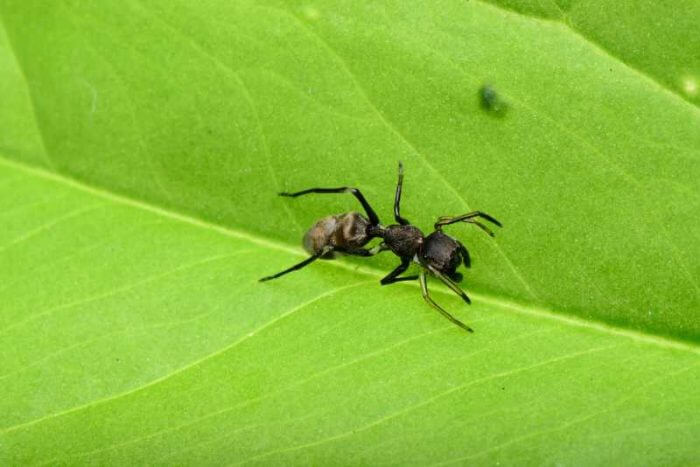
These sacs are often found on tree bark, under rocks, or in other protected areas. At night, the spider emerges from its sac to hunt for prey.
Characteristics
- They have an ant-like appearance
- Body is elongated and flattened
- Typically reddish-brown or black, in color with white almost cream patches on their abdomen.
Habitat
- Native to North America and Canada
- reddish-brown or black, with white almost cream patches on their abdomen.Cane be found on the ground, under rocks and logs, or dead rotting leaves
Final Thoughts About Black and White Spiders
So there you have it! There are 24 black and white spiders species! If you did make it to the end of this article then congratulations as we know how long this post is!
However, we didn’t want to miss a thing! and to also make sure that we provided you with a little bit of background of each spider.



